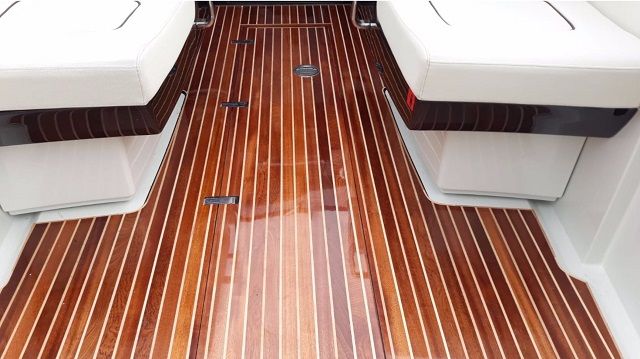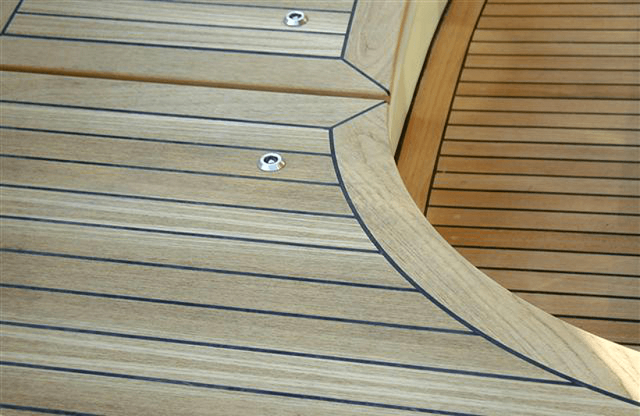Expert guidance for repairing teak deck rubber seams in Valencia

Maintaining the pristine condition of your yacht's teak deck is essential for both aesthetic appeal and structural integrity. Over time, the rubber seams of teak decks can deteriorate, leading to leaks and other issues. In Valencia, where maritime culture thrives, finding expert guidance for repairing these seams is crucial. In this article, we'll explore the main concerns surrounding teak deck seam restoration, showcase inspirational examples of wooden teak decks, discuss contractors specializing in this service in Valencia, and provide insights into the costs involved in wooden teak deck restoration. On our homepage, you can read more about our exceptionally high-quality and beautifully finished wooden design products at realistic prices. (To ensure the privacy of our customers, you can contact us for references.)
Buitenschrijnwerk also builds and repairs wooden teak decks in the following regions and cities: Costa Brava, Costa del Sol and Alicante.
These are all our working areas.
Main concerns when you wish to have your teak deck seams restored
When considering restoring the rubber seams of your wooden teak deck in Valencia, several key concerns should be addressed:
- Water intrusion: Deteriorated rubber seams can allow water to penetrate the deck, leading to moisture damage and rot in the underlying structure.
- Safety hazards: Loose or damaged seams pose tripping hazards for passengers and crew members, emphasizing the importance of timely repair.
- Aesthetic appeal: Teak decks are prized for their beauty, and deteriorating seams can detract from the overall appearance of your vessel.
- Longevity: Proper maintenance, including seam restoration, can prolong the lifespan of your wooden teak deck, ensuring years of enjoyment on the water.
- Environmental impact: Teak deck restoration often involves the use of various chemicals, sealants, and cleaning agents. It's essential to consider the environmental impact of these products and opt for eco-friendly alternatives whenever possible. Minimizing the use of harmful chemicals and adopting sustainable practices not only benefits the marine ecosystem but also aligns with the principles of responsible stewardship of our oceans and waterways.
Addressing these concerns promptly with expert guidance is essential to ensure the longevity and performance of your teak deck.
Do you need some extra advice? Feel free to contact us.

Inspirational examples of wooden teak decks
Wooden teak decks evoke a sense of timeless elegance and craftsmanship. Here are some inspirational examples to fuel your imagination:
- Classic yachts: Traditional sailing vessels with meticulously maintained teak decks exude nautical charm and sophistication.
- Luxury motor yachts: Modern motor yachts often feature expansive teak decks, providing luxurious outdoor spaces for relaxation and entertainment.
- Historic vessels: Restored historic ships with authentic wooden teak decks showcase the enduring beauty and durability of this material.
These examples highlight the versatility and enduring appeal of wooden teak decks, inspiring owners to preserve and enhance their own vessels.
Contractors for teak deck rubber seams repair in Valencia
In Valencia, several reputable contractors specialize in teak deck rubber seam repair. When selecting a contractor, consider the following factors:
- Experience: Choose a contractor with extensive experience in repairing teak decks and rubber seams on various types of vessels.
- Quality of workmanship: Insist on high-quality materials and craftsmanship to ensure lasting results.
- Customer reviews: Seek recommendations and read reviews from previous clients to gauge the contractor's reputation and satisfaction level.
- Professionalism: Look for contractors who prioritize clear communication, timeliness, and professionalism throughout the project.
Buitenschrijnwerk is also very experienced in building wooden jetties.
Costs for wooden teak deck restoration
The cost of restoring a wooden teak deck, including repairing rubber seams, can vary depending on several factors:
- Size of the deck: Larger decks will require more materials and labor, resulting in higher costs.
- Extent of damage: Severe deterioration may necessitate more extensive repairs, impacting the overall cost.
- Materials used: The quality of materials, such as marine-grade teak and premium rubber sealants, will influence the final cost.
- Labor and expertise: Skilled labor is essential for achieving quality results, and labor costs will factor into the overall expense.
While the cost of teak deck restoration is an investment, it's essential to prioritize quality to ensure the longevity and value of your vessel.
In conclusion, expert guidance is invaluable when it comes to repairing teak deck rubber seams in Valencia. By addressing concerns promptly, drawing inspiration from exemplary teak deck designs, selecting reputable contractors, and understanding the costs involved, yacht owners can embark on a journey toward restoring and preserving the beauty and functionality of their vessels for years to come.
Request a quote to have your teak deck rubber seams on your yacht or ship repaired
Frequently asked questions about ship decks
WHAT ARE THE BENEFITS OF A TEAK BOAT DECK?
Teak ship decks are top because of their durability, non-slip qualities, attractive look, low maintenance, and thermal insulation. This makes them the perfect choice for ships, especially those in salty waters. In short, teak has long been a favorite for ship decks because of its blend of strength, safety, beauty, and easy maintenance.
HOW DO I MAINTAIN A TEAK SHIP DECK?
To keep your teak boat deck in top condition and maintain its beauty, follow these steps:
- Clean it regularly with a soft brush, water and mild soap.
- Occasionally give it a thorough scrub with water and teak cleaner.
- Maintain its color and luster by regularly oiling it with special teak oil.
- Optional: delay aging by regular cleaning and oiling, or use special products for this purpose.
- Avoid sanding and aggressive cleaning methods.
- Inspect regularly for damage and repair if necessary.
Performing these simple steps regularly will keep your teak boat deck looking and performing beautifully for years to come.
CAN I INSTALL A TEAK DECK MYSELF OR DO I NEED PROFESSIONAL HELP?
Installing a teak deck can be challenging and requires specific skills and tools. Consider whether you can handle the project yourself, depending on your experience, available resources and project size. Important considerations include:
- Experience: Weigh whether you have experience with carpentry and flooring. If not, professional help is wise.
- Tools: Make sure you have all the tools you need, such as saws and drills.
- Time and commitment: It can take a lot of time and commitment, especially on large or complex projects.
- Budget: Consider the cost savings of doing it yourself versus the cost of any mistakes.
If in doubt, professional help is recommended. This will ensure efficient installation to proper standards.
HOW LONG DOES A TEAK DECK LAST ON AVERAGE?
A teak deck can last a long time with proper maintenance, thanks to factors such as wood quality, exposure to weather, and regular cleaning and oiling. With care, some decks can last more than 20 years. But without regular maintenance, teak can deteriorate from moisture, salt water and sunlight, shortening its life through cracking, discoloration or rot. With attention to maintenance, a teak deck will remain a worthwhile investment for many years to come.
WHAT IS THE DIFFERENCE BETWEEN SOLID TEAK AND TEAK VENEER FOR MARINE DECKS?
Solid teak and teak veneer are both used for ship decks, but differ in important ways:
- Material structure: Solid teak consists of complete pieces of teak, while teak veneer is thin layers of teak glued to plywood or MDF.
- Cost: Solid teak is more expensive because of the amount of material and labor, while teak veneer is cheaper because of less teak and a cheaper base.
- Ease of installation: Solid teak is heavier and often requires professional installation, while teak veneer is lighter and easier to cut and adjust.
- Maintenance: Solid teak requires regular sanding and varnishing, while teak veneer is usually already finished but may require repairs.
The choice depends on budget, weight, ease of installation and personal preference.
HOW CAN I REMOVE STAINS OR DISCOLORATION ON MY TEAK DECK?
Removing stains on a teak deck requires careful steps:
- Start by cleaning with water and mild soap.
- For stubborn stains, light sanding with fine sandpaper may help.
- Use commercial teak cleaner according to instructions.
- Deep stains may require bleach, but be careful.
- Finish by applying new deck oil to protect the deck.
If deep stains or in doubt, consult a professional.
WHAT TREATMENTS OR FINISHES ARE NEEDED TO KEEP A TEAK DECK IN GOOD CONDITION?
To maintain a teak deck, consider the following:
- Cleaning: Use mild soap and water to remove dirt without damaging the wood.
- Sanding: Periodically sand to level rough spots and prepare the surface.
- Oil treatment: Protect the wood from moisture and wear by applying teak oil evenly.
- Sealing: Add additional protection with an appropriate sealer after thorough cleaning and drying.
- Periodic maintenance: Check regularly for wear and tear and take timely action.
With these careful treatments, your teak deck will remain in top condition and retain its natural beauty.
HOW TO PREVENT A TEAK DECK FROM BECOMING SLIPPERY?
To prevent slipperiness on a teak deck, follow these tips:
- Keep the deck clean to remove dirt and organic material.
- Use an anti-slip treatment specifically for teak decks.
- Place rubber or non-slip mats on high-traffic walking areas.
- Wipe away excess water after rainfall.
- Consider a roughened finish for more grip.
- Wear shoes with good grip, especially in wet weather.
By taking these measures, you will reduce the risk of slipping on your teak deck and improve safety.
ARE THERE ALTERNATIVE MATERIALS TO TEAK SUITABLE FOR SHIP DECKS?
There are several alternative materials for marine decks that can replace teak:
- Synthetic teak, such as PVC or EVA, offers durability, ease of maintenance and resistance to moisture and UV rays, with a similar appearance to real teak.
- Rubber decking is non-slip, durable and resistant to water, abrasion and UV rays, available in a variety of colors and textures.
- Compressed wood fiberboard (CWP), also known as composite wood, is strong, durable and moisture- and rot-resistant.
- Aluminum decks are lightweight, corrosion-resistant, low-maintenance and offer a modern look, especially in modern yachts and boats.
- Composite materials such as glass fiber reinforced plastic (GRP) or carbon fiber composites are lightweight, strong and corrosion resistant.
The right choice depends on budget, aesthetics, maintenance needs and usage conditions, so consider carefully before making a decision and seek expert advice.
WHAT IS THE COST OF INSTALLING AND MAINTAINING A TEAK BOAT DECK?
The cost of installing and maintaining a teak boat deck can vary widely because of several factors, including deck size, teak type, installation complexity and finishes. Consider these cost considerations:
- Installation: Labor-intensive work includes removing the old deck, surface preparation, fitting boards and applying finishes. Costs can range from thousands to tens of thousands of dollars.
- Teak prices: Depending on quality, origin and dimensions, teakwood costs can vary widely, including market fluctuations and import costs.
- Maintenance: Periodic cleaning, oiling, sealing and repairs are required. Annual maintenance costs range from several hundred to thousands of dollars, depending on deck size and services chosen.
Set a budget, gather quotes from professionals and consider additional costs such as transportation and contingencies.


